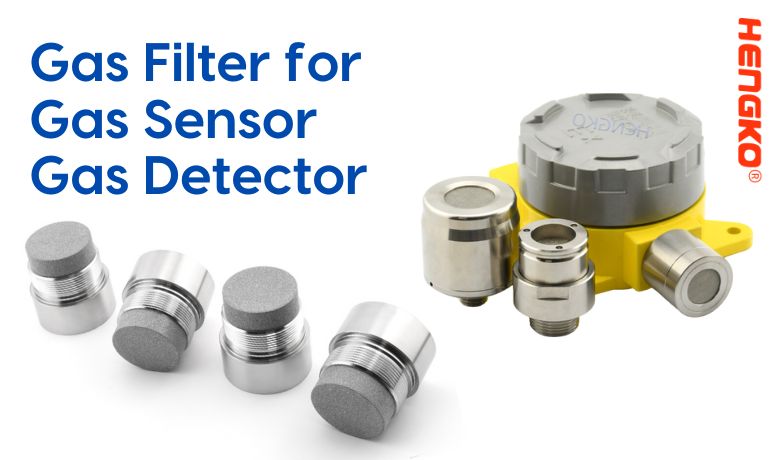-

Industry gas sensor housing for flameproof fixed, gas sensor
Stainless Steel Explosion-proof filter is mainly used in aviation maintenance enterprises, used to filter gasoline, kerosene, oil, and hydraulic oil. It is a...
View Detail -
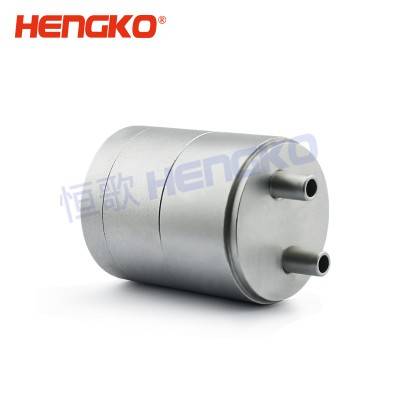
Industrial grade explosion-proof combustible gas detector sensor housing for high preci...
These flameproof gas sensor heads that can be fitted with a range of different sensor technologies (infrared, pellistor, electrochemical) for detection of Hy...
View Detail -

Explosion-proof sintered porous water proof stainless steel probe housing with maximum ...
HENGKO explosion-proof sensor housing is made of 316L stainless steel and aluminum for maximum corrosion protection. A sinter-bonded flame arrestor provides ...
View Detail -

Sintered stainless steel/wire mesh explosion-proof filter housing for carbon monoxide l...
HENGKO explosion-proof sensor housing is made of 316L stainless steel and aluminum for maximum corrosion protection. A sinter-bonded flame arrestor provides ...
View Detail -

Waterproof porous sintered stainless steel 316L/316 explosion-proof probe gas analyzer ...
HENGKO explosion-proof sensor housing is made of 316L stainless steel and aluminum for maximum corrosion protection. A sinter-bonded flame arrestor provides ...
View Detail -

Porous sintered stainless steel 304/316 waterproof and explosion-proof gas sensor prob...
Experience Uncompromising Corrosion Protection with our 316 Stainless Steel Explosion-Proof Sensor Assemblies! Introducing our cutting-edge explosion...
View Detail -

Porous sintered stainless steel 316L waterproof & explosion-proof gas sensor probe...
HENGKO explosion-proof sensor housing is made of 316L stainless steel and aluminum for maximum corrosion protection. A sinter-bonded flame arrestor provides ...
View Detail -
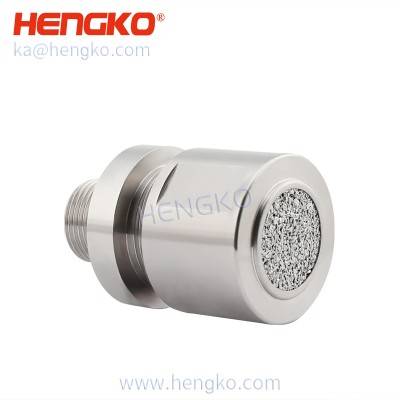
waterproof porous stainless steel explosion-proof gas sensor probe protective covers wi...
HENGKO explosion-proof sensor housing is made of 316L stainless steel and aluminum for maximum corrosion protection. A sinter-bonded flame arrestor provides ...
View Detail -

Flame arrester stainless steel explosion-proof gas detector sensor probe enclosure for ...
HENGKO explosion-proof sensor housing is made of 316L stainless steel and aluminum for maximum corrosion protection. A sinter-bonded flame arrestor provides ...
View Detail -

Custom gas detection explosion-proof stainless steel gas analyzer filter housing with m...
HENGKO explosion-proof sensor housing is made of 316L stainless steel and aluminum for maximum corrosion protection. A sinter-bonded flame arrestor provides ...
View Detail -

Handheld Smart Ethylene Gas Sensor Test Analyzer Detector with Stainless Steel Aluminum...
HENGKO gas sensor detector is a kind of intelligent digital gas sensor device, which provides comprehensive monitoring of combustible, toxic gas hazards in ...
View Detail -
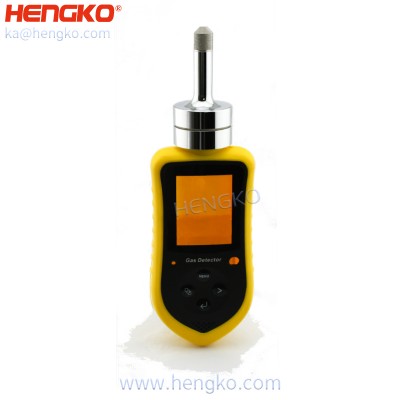
Flameproof Explosion-proof Housing for Combustible Oxygen Gas Leak Sensor Detector
HENGKO gas sensor detector is a kind of intelligent digitalgas sensor device, which provides comprehensive monitoring of combustible, toxic gas hazards in po...
View Detail -
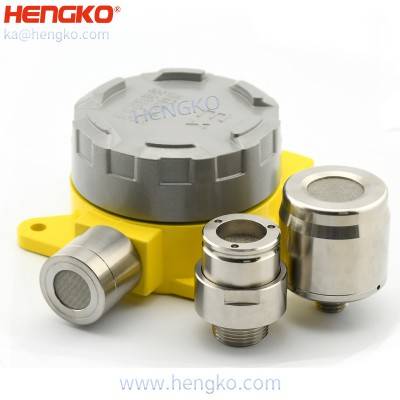
Affordable explosion-proof assembly fitted with a combustible gas detection sensor with...
Gas type: combustible gas、poisonous gases、oxygen、ammonia chlorine、carbon monoxide、hydrogen sulfide Applications: gas detectors for a broad range of moni...
View Detail
Types of Gas Sensor and Gas Detector Housing
In order to choose a right and better gas sensor or detector housing for your product,
let's check what type of your gas sensor or gas detector at first.
Gas sensors and gas detector housings are essential components of safety systems in a variety of industrial and residential settings. They work together to detect the presence and concentration of hazardous gases, providing early warning of potential dangers and allowing for timely evacuation or mitigation measures.
Types of Gas Sensors
There are several different types of gas sensors, each with its own strengths and weaknesses. Some of the most common types include:
1. Electrochemical sensors:
These sensors use a chemical reaction to generate an electrical signal that is proportional to the
concentration of the target gas.
They are sensitive to a wide range of gases, including toxic gases, flammable gases, and oxygen.
2. Metal oxide semiconductor (MOS) sensors:
These sensors use the electrical conductivity of a metal oxide semiconductor to detect the presence of gases.
They are particularly sensitive to reducing gases, such as hydrocarbons and carbon monoxide.
3. Catalytic bead sensors:
These sensors use a catalytic reaction to generate heat, which is then measured to determine
the concentration of the target gas. They are primarily used to detect combustible gases.
4. Infrared (IR) sensors:
These sensors use infrared light to detect the absorption of gas molecules.
They are particularly sensitive to certain gases, such as carbon dioxide and methane.
5. Photoionization detectors (PIDs):
These sensors use ultraviolet (UV) light to ionize gas molecules,
which are then detected by an electric field.
They are sensitive to a wide range of organic gases,
including volatile organic compounds (VOCs).
Gas Detector Housings
Gas detector housings are designed to protect gas sensors from the environment and to provide a safe and secure environment for them to operate. They are typically made of durable materials, such as stainless steel or aluminum, and are often sealed to prevent the ingress of dust, moisture, and other contaminants.
There are several different types of gas detector housings, each designed for a specific application. Some of the most common types include:
1. Flameproof housings:
These housings are designed to prevent the ignition of flammable gases in the event of a leak.
They are typically used in hazardous areas, such as oil refineries and chemical plants.
2. Explosion-proof housings:
These housings are designed to withstand the pressure of an explosion.
They are typically used in areas where there is a high risk of explosions,
such as mines and offshore drilling platforms.
3. Intrinsically safe housings:
These housings are designed to prevent the passage of sparks or other sources of ignition
into the housing. They are typically used in areas where there is a risk of electrical sparks, such as grain silos and paper mills.
4. Weatherproof housings:
These housings are designed to protect gas sensors from the elements,
such as rain, snow, and dust. They are typically used in outdoor applications.
Applications of Gas Sensors and Gas Detector Housings
Gas sensors and gas detector housings are used in a wide variety of applications, including:
* Industrial safety:
Gas sensors and gas detector housings are used to monitor for the presence of hazardous gases in industrial settings, such as factories, refineries, and chemical plants.
* Environmental monitoring:
Gas sensors and gas detector housings are used to monitor for the presence of air pollutants, such as carbon monoxide, sulfur dioxide, and nitrogen oxides.
* Firefighting:
Gas sensors and gas detector housings are used by firefighters to detect the presence of hazardous gases in burning buildings.
* Home safety:
Gas sensors and gas detector housings are used in homes to detect the presence of carbon monoxide, natural gas, and other hazardous gases.
Gas sensors and gas detector housings are essential safety devices that play a critical role in protecting people and property from harm.
Main Features of Gas Sensor and Gas Detector Housing
The housing of a gas sensor is an important component that helps protect the sensor and its associated circuitry from environmental factors, while providing an enclosure that allows specific gas(es) to reach the sensor for accurate detection. The main features of a gas sensor housing typically include:
1. Material:
The housing is often made from materials that are resistant to corrosion and other forms of damage that might be caused by gases and other environmental factors. These materials could include different types of plastics, metals like stainless steel, or specialized materials for harsh environments.
2. Gas Inlet and Outlet:
The housing will typically have a gas inlet and an outlet. These allow the target gas to enter the housing and reach the sensor, and then leave the housing. The design of these inlets and outlets can be crucial to ensuring accurate sensor readings.
3. Protection against Environmental Conditions:
The housing design usually incorporates features that protect the sensor from dust, humidity, extreme temperatures, and other environmental conditions that might interfere with the sensor's operation or damage it. This could involve the use of gaskets, seals, or other protective measures.
4. Mounting Mechanisms:
Depending on the application, the housing might include specific features for mounting the sensor in its operational location. This could include screw holes, brackets, or other mechanisms.
5. Electrical Connections:
The housing will also have provisions for electrical connections, allowing the sensor to interface with the rest of the system. This could involve terminals, sockets, or cable glands.
6. Miniaturization:
As technology progresses, there's a continuous drive for smaller and more efficient devices. Miniaturized housings that still provide optimal functionality are an ongoing trend.
7. Explosion-proof Design:
For sensors used in environments with flammable gases, the housing might be designed to be explosion-proof. This typically involves a robust construction that can contain an internal explosion without allowing it to ignite gases in the surrounding environment.
8. EMI/RFI Shielding:
Some housings might incorporate shielding to protect the sensor and its electronics from electromagnetic interference (EMI) or radio frequency interference (RFI).
9. Easy Maintenance and Calibration Access:
The housing is usually designed to allow easy access for maintenance or calibration of the sensor. This could involve removable covers or other access features.
10. Regulatory Compliance:
Depending on the region and application, the housing might need to comply with specific regulatory standards. This can involve aspects of its design, the materials used, and other factors.
You Can Check Sensor Housing of Explosion Proof Gas Detector Products Details For The Follow Video,
Where to install for the Gas Sensor Housing ?
Where to install the housing of a gas sensor can significantly depend on the type of gas to be detected, the sensor's specifications, and the specific conditions of the environment in which the sensor is to be used. Nevertheless, there are some general considerations for installing gas sensor housing:
1.Location of Gas Presence: Ideally, the gas sensor should be placed in areas where the gas leak is most likely to occur or where it's expected to accumulate. For example, since propane is heavier than air, sensors detecting propane should be placed low to the ground. Conversely, since methane is lighter than air, sensors for methane should be located near the ceiling.
2.Ventilation: The sensor should be placed in a well-ventilated area to allow the gas to reach the sensor effectively.
3.Avoid Obstructions: The sensor should be installed in a location that is free from obstructions to ensure the gas can freely reach the sensor.
4.Avoid Sources of Heat and Ignition: The sensor should be located away from sources of heat, open flames, or other potential ignition sources, particularly if the sensor is intended to detect flammable gases.
5.Away from Corrosive or Contaminating Substances: The sensor should be positioned away from direct contact with corrosive or contaminating substances, which might interfere with its operation or cause damage.
6.Access for Maintenance: The sensor should be installed in a location that allows for easy access for routine maintenance, calibration, and potential repairs or replacement.
7.Compliance with Regulations: Regulations may require gas sensors to be located in specific locations or require multiple sensors for comprehensive monitoring.
8.Avoidance of Extreme Conditions: Although the housing is designed to protect the sensor, it's still best to avoid placing it in areas of extreme heat, cold, humidity, or areas prone to heavy mechanical impacts or vibrations.
9.Near Potential Sources of Gas Leaks: In industrial environments, the gas sensor should be installed close to potential gas leak sources, such as pipelines, valves, fittings, or storage containers.
FAQ
Q1: What materials are typically used for gas sensor housings and why?
A1: Gas sensor housings are usually made from materials that are robust, durable, and resistant to the harsh environments in which they are often installed. These materials can vary but are frequently different types of plastics or metals. For example, ABS plastic is often used due to its strength, resistance to chemicals, and affordability. In more demanding environments, stainless steel or other corrosion-resistant metal alloys might be used because of their durability and ability to withstand higher temperatures and pressures. The material chosen for the housing must also be non-reactive with the gas or gases to be detected to avoid interference with the sensor's operation.
Q2: How does the design of the gas inlet and outlet in the housing affect sensor performance?
A2: The design of the gas inlet and outlet in the housing is vital to the sensor's performance. They are designed to allow the target gas to reach the sensor and any non-target gases or spent target gases to be vented away. If the design is suboptimal, it might limit the rate at which gas reaches the sensor, slowing response time, or it could allow the accumulation of non-target gases, potentially leading to incorrect readings. The size, shape, and location of the inlets and outlets are all aspects that could affect sensor performance.
Q3: What protective measures against environmental conditions are integrated into a gas sensor housing?
A3: Gas sensor housings typically incorporate several protective measures against environmental conditions. This can include seals or gaskets to protect against dust or moisture ingress, heat-resistant materials or insulators to protect against high temperatures, and robust construction to protect against physical damage. In some cases, the housing may also include shielding to protect the sensor and its electronics from electromagnetic interference (EMI) or radio frequency interference (RFI). These protective measures help ensure that the sensor continues to function correctly in various environments and conditions.
Q4: How is the mounting of the gas sensor housing typically managed?
A4: The mounting of the gas sensor housing depends on the application, but it is typically designed to be flexible and adaptable to various scenarios. The housing might include features like screw holes, mounting brackets, or slots for zip ties to facilitate attachment to walls, ceilings, machinery, or other structures. Some gas sensor housings are designed to be easily moved or repositioned, allowing for temporary or portable installations. When mounting the sensor, it's important to ensure that the gas inlet and outlet are not obstructed and that the sensor is positioned correctly for the gas to be detected.
Q5: Why is easy access for maintenance and calibration important in gas sensor housing design?
A5: Routine maintenance and calibration are critical to ensuring that a gas sensor continues to function correctly and provide accurate readings. Over time, sensor performance can drift, or the sensor may become dirty or otherwise require maintenance. Therefore, the housing design often allows for easy access to the sensor for these tasks. This might involve removable covers or doors, access ports, or even modular designs that allow the sensor to be easily removed and replaced. This ensures that the sensor can be easily maintained, leading to better long-term performance and potentially extending the life of the sensor.
Q6: What are some considerations for installing gas sensor housing in potentially explosive environments?
A6: When installing gas sensors in potentially explosive environments, the housing may need to be explosion-proof or intrinsically safe. This typically involves a robust construction that can contain an internal explosion without allowing it to ignite gases in the surrounding environment. It also means that the electronics associated with the sensor must not produce sparks or other ignition sources, even under fault conditions. The housing should be certified to appropriate standards (such as ATEX in Europe or Class/Division standards in the U.S.) to demonstrate that it has been designed and tested to safely operate in these conditions. Always consult the relevant regulations and standards for your region and industry to ensure proper installation and safety.
Q7: What are the key factors to consider when choosing the location to install a gas sensor housing?
A7: When choosing a location to install a gas sensor housing, there are several key factors to consider. First, the sensor should ideally be placed in areas where the gas leak is most likely to occur or where the gas is expected to accumulate. For example, for gases heavier than air, the sensor should be placed low to the ground, and for lighter gases, near the ceiling. The sensor should be in a well-ventilated area, away from obstructions, and distanced from sources of heat or potential ignition. It's also essential to avoid placing it in areas with high humidity, corrosive substances, or extreme conditions unless the housing is specifically designed to withstand these factors. Lastly, ensure that the sensor is installed where it can be easily accessed for routine maintenance and calibration.
Any more questions for the Petrochemical Industry Gas Explosion-Proof Application and Custom Service,
Please feel free to contact us by email ka@hengko.com or send inquiry as follow form. Thanks!
